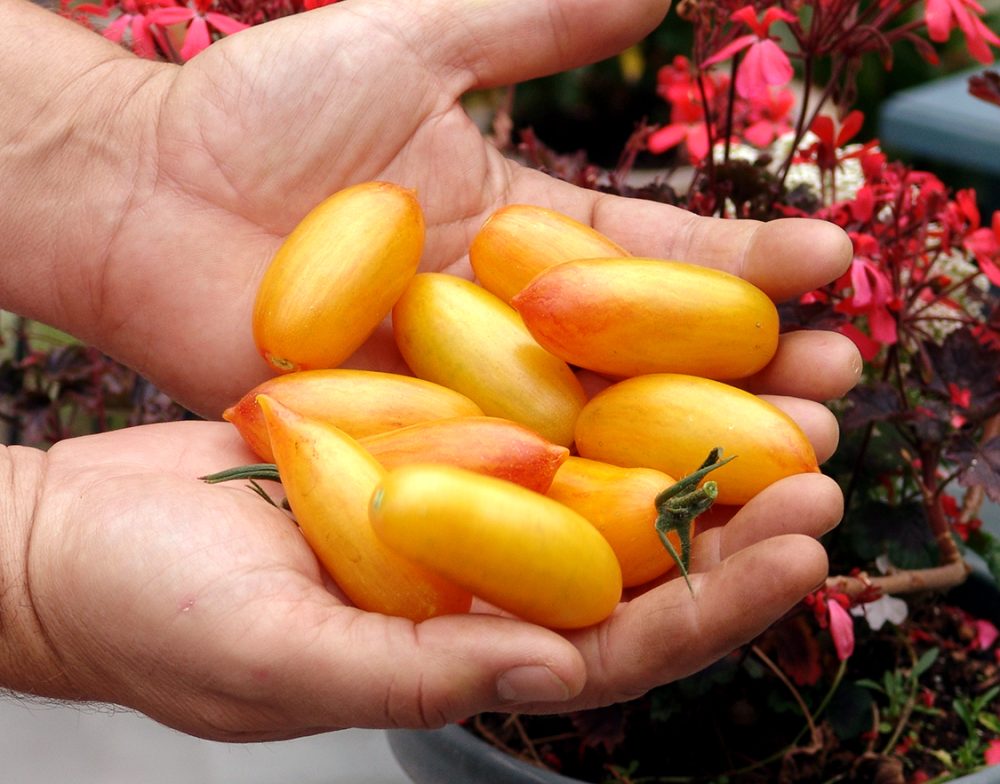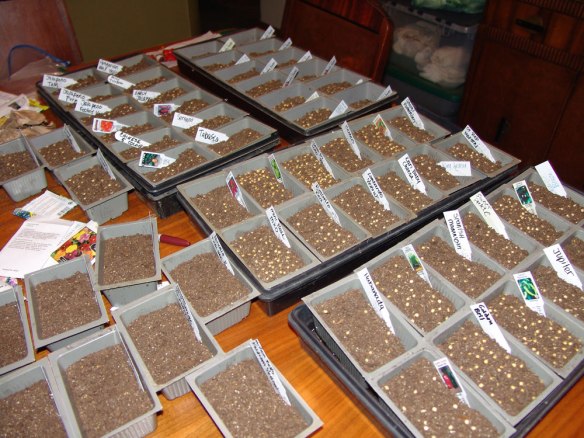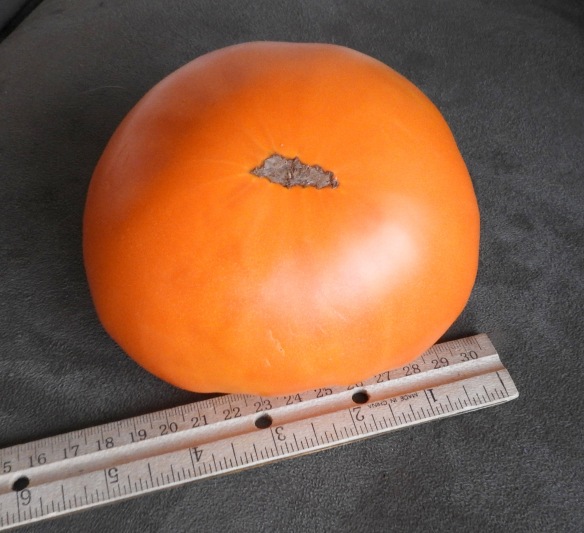by Darius Van d’Rhys
Softneck garlics are well adapted to warmer climates. It is softneck garlic that you are likely to find in the grocery store, because softneck garlic stores and travels better than hardneck. The types of softneck garlic you are most likely to encounter are Artichokes (with a sub-group of Turbans) and Silverskins.
Artichoke Garlic
Artichoke garlics (sativums or softnecks) are the most commonly grown commercial garlic because they are easier to grow and produce larger bulbs than most other garlics. They store well and this is what you probably buy at the grocer’s. In fact, most people aren’t even aware that there is more than one kind of garlic.
Artichoke garlics are generally very large, and have a wide range of flavors with some like Simoneti and Red Toch being very mild and pleasant and others such as Inchelium Red and Susanville, have greater depth of flavor. Purple Cauldron (in the sub-group Asiatics, now considered a hardneck garlic) is much stronger and sticks around for a while. Chinese Purple (another hardneck Asiatic) is instantly hot!
The Turban sub-group of artichoke garlics tend to be the most colorful artichokes and have fewer cloves per bulb than the others. The turbans also harvest earlier and store less long than the other artichokes and a good bit stronger in taste as well. (I didn’t find much information on the turban garlics, sorry.)
Some Artichoke Garlic Varieties
‘Kettle River Giant’, giant bulbs, 10-15 cloves/bulb, early harvest, medium, stores 6-7 months.
‘Inchelium Red’ Harvests mid-season – stores 6-7 months. Grows very well in warm winter areas. In 1990 Rodale Kitchens, part of the parent organization of Organic Gardening magazine, sponsored a garlic tasting contest. Inchelium Red won. It usually has anywhere from 12 to 20 cloves and is large enough that even the interior cloves are generally of good size. Bulbs are usually over 2 and a half inches in diameter and will weigh several ounces each.
‘Red Toch’ Harvests early in season – stores 6-7 months. Semi-rich but very mellow. Grows very well in warm winter areas. It is not quite as mild as Chet’s and not quite as strong as Inchelium Red. Red Toch averages fairly large bulbs that are a little larger than Chet’s but not as large as Simoneti or Inchelium Red.
‘California Early’ Harvests Mid-late season – stores 6-7 months. This one of the two Gilroy cultivars is the one you’re least likely to find in the local supermarkets because it is processed into dried and pickled and otherwise processed garlic products. California Early is a little bigger and sweeter than California Late, which is definitely on the hot side. Cal Early is an excellent all- around general use garlic and a wonderful baker.
‘Applegate’ is a mild and mellow artichoke garlic and is a good garlic to grow in warm winter areas.
‘Early Red Italian’ Harvests early in season – stores 6-7 months. It has a semi-rich flavor and a little bite, but is still on the light side.
‘Lorz Italian’ An Heirloom Garlic. Excellent strong garlic for warm winter gardeners. Harvests mid season – stores 6-8 months.
‘Thermadrone’ from France, Harvests in early-mid season – stores 6-7 months.
‘Simoneti‘ Harvests in mid-season – stores about 6 months.
‘California Late’ Harvests Mid-late season – stores 6-7 months. One of the two cultivars you’re most likely to find in the local supermarkets, along with California Early. California Late is a little on the hot side and has more color. it is a prolific grower and a good commercial garlic
‘Siciliano’ Harvests mid season – stores about 6 months. Rich flavor, zesty medium pungency. Its richness makes it excellent for raw eating as in pesto or salsa.
Some Turban Artichoke Varieties
‘Chinese Purple’ Harvests VERY early in season – stores 5-6 months. Very strong garlic taste with a fierce heat.
‘Shantang Purple’ – Limited supply, Hot, 6-8 cloves/bulb, good for many climates.
‘Maiskij’ – This Turban garlic originated in Turkmenistan, one of those small, mountainous Islamic republics near Chechnia. The taste is medium strong, leaning toward being bold, but not overpowering.
‘Silverwhite’, almost mellow taste for 15 to 20 seconds before you experience an intense heat that lasts for about 30 to 45 seconds. Good to Fair for Warm Winter Areas, Harvests late season – stores 8-10 months.
Silverskin Garlic
Silverskins have silvery, white skins and are composed of many small cloves. They also have a nice sturdy neck that is easily braided. The flavor of Silverskins is usually stronger than Artichokes. ‘Nootka Rose‘ and ‘Rose du var‘ are both full-bodied Silverskins.
Silverskin garlics are in a class by themselves. They are the last garlics to mature and they store the longest. They also have a great range of taste, pungency, and size as well as time of maturity. No other garlics braid better than Silverskins and they will grow well in most of the USA.
S & H Silverskin has a musky, earthy taste with very little bite when eaten raw. Locati can be fiery hot. Silverwhite has a richness to it and seems almost mellow for 15 to 20 seconds before you experience an intense heat that lasts for about 30 to 45 seconds. Nootka Rose has that same richness but with only a medium heat. Silverskins have more cloves per bulb, on the average, than the artichokes and some, like Mexican Red Silver have a lot of tiny cloves while others, like S & H Silverskin and Silverwhite have almost all large cloves with very few small ones.
Some Silverskin Garlic Varieties
‘S & H Silverskin’ has a musky, earthy taste with very little bite when eaten raw.
‘Nootka Rose’ Heirloom from Washington State, rich, bold taste with medium heat, large mahogany cloves, 15-20 per bulb. , Fair for Warm Winter Areas, Long storing.
‘Locati’, can be fiery hot. Fair for Warm Winter Areas, 11-12 cloves/bulb. Harvests late season – stores 8-10 months.
‘Rose du Var’, bold, strong and long French garlic taste. 8-12 cloves/bulb Harvests late season – stores 8-10 months.
Other Silverskin varieties include ‘Mexican Red Silver’, ‘Sicilian Silver’ ,’Silver Rose’, and ’Mild French’.

















 What Kind to Grow, and Where
What Kind to Grow, and Where







 Meet Fred’s Tye Dye. I don’t know who Fred is but I love his tomato. This is another tomato out of the Dwarf Tomato Project. It is the most beautiful color, hopefully you can see the stripes in this picture, it is from my garden. The taste was delicious. The growth habit very manageable as you can see below. This is a mid season producer and is one of the taller dwarfs although mine didn’t get any taller than 4 feet. It was one of the first ones to color up. As with any heirloom, size varies from baseball to softball size. One of the other things I like about the dwarfs is their stocky stems and their rugose, regular leaves, very crinkly and dark green.
Meet Fred’s Tye Dye. I don’t know who Fred is but I love his tomato. This is another tomato out of the Dwarf Tomato Project. It is the most beautiful color, hopefully you can see the stripes in this picture, it is from my garden. The taste was delicious. The growth habit very manageable as you can see below. This is a mid season producer and is one of the taller dwarfs although mine didn’t get any taller than 4 feet. It was one of the first ones to color up. As with any heirloom, size varies from baseball to softball size. One of the other things I like about the dwarfs is their stocky stems and their rugose, regular leaves, very crinkly and dark green.